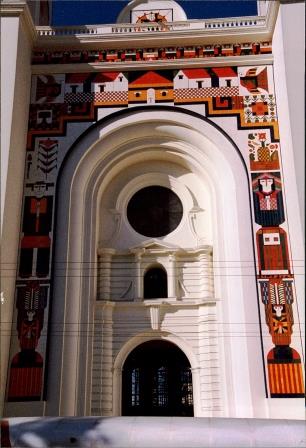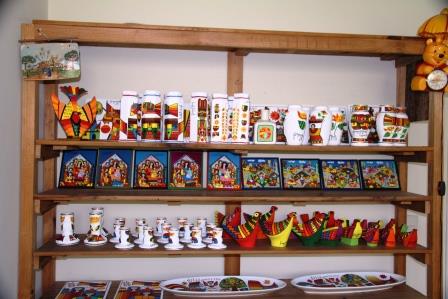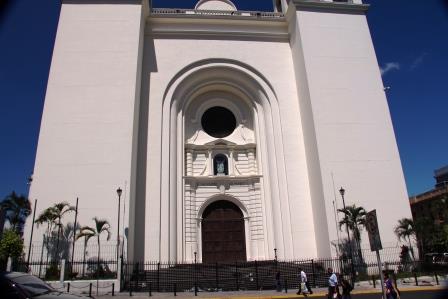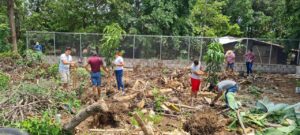Editor’s Note: These were the first words this celebrated Salvadoran artist, Fernando Llort, spoke to us catching us quite by surprise. We were blessed with the opportunity to spend the morning welcomed into the home of this renowned artist and mentor whose prestigious work is recognized and exhibited worldwide. His original style is instantly recognizable with its unique, eye-catching quality of bright, primary colors bursting full of life with symbols of religion and nature.
Born in San Salvador to a family of means in 1949, he was educated abroad in the 1960’s but felt a tug to return to El Salvador to live and fulfill his passion for art. Fernando Llort has not lived his life creating pieces for his own expression or self-edification. He has taught his painting technique to countless campesinos in order to empower them to earn a sustainable, dignified living.
You have such a wide range of interests in your educational background including studying architecture at the University of El Salvador, art in France and Louisiana State University, philosophy and theology in Belgium. Do you see all of these areas manifesting themselves within your art?
Yes, of course. In France I was very influenced by Matisse. My first exhibition was in Toulouse. They asked me where I was from and what my culture was, so I felt it was necessary to express it. Art had always been a way for me to express myself even as a young child.
When I studied philosophy, I decided I wanted to become a priest and studied in a seminary in Belgium. But I found myself spending all my free time dedicating myself to painting. I discovered my vocation was painting rather than the priesthood. I have been painting for 47 years. I also knew I wanted to share my God-given talents and skills with others.
I kept thinking about the emphasis in Europe to discover one’s cultural identity, so I returned to El Salvador to paint here. I prayed that God would give this artist inspiration through the joy and hope of the people.
When you returned to El Salvador, it was in the midst of social and political unrest. How and where does an artist find a place to create in that environment?
My father had wanted me to choose a professional career and didn’t feel I could survive on my art. But my vocation for painting was stronger. I decided to continue painting in a setting where I could be by myself, discover myself, and learn more about God.
My father owned a house in La Palma, which is a small town in northern Chalatenango department near the Honduran border. I had fond memories of visiting there as a child with my parents and five siblings. It was a place I loved where I had a connection with nature. I had always sculpted the trees, houses, and land. There were lots of birds, mountains, and flowers. Nature inspires me and influences my paintings.
You have been credited with turning La Palma into a thriving artisan community. How did that begin and how has it developed?
One day I noticed a small child playing in the earth with a coconut seed, and I asked him to show me what he was doing. He was making a painting inside it. Painting coconut seeds developed into other media such as wood, and soon many individuals showed interest in learning to paint.
I met my beautiful wife, Estella, in this village and married her. Her family, as well as some people in the village, came to see what I was doing. I prayed, “Please God, help me know what to do with these people.” I was 24 years old and felt it was God bringing these people so I could teach them, so I put my drawings on a wall for them to copy and imitate. Sixty people worked in the first workshop.
My Christian values guided me to form on August 27, 1977, a cooperative we called “La Semilla de Dios” (God’s Seed), which eventually became the Center for Internal Development, an art school to benefit and provide sustainable income to many families. People came and learned the skills and then went to their homes to do the work. There are now 134 workshops in the La Palma area and roughly 10,000 individuals have learned marketable skills.
Did you feel you had a passion for God on the one hand and a passion for the people on the other hand? How has this decision impacted you?
Yes, definitely. I have a faith in God and in my people.
Do you see yourself as having been a human rights activist?
Yes, because at that time women’s roles were limited to being a housekeeper. The workshops allowed women to work and increased their dignity. Some women learned to drive and came into San Salvador to sell their wares. Some husbands and wives worked together side by side in the workshops.

Llort’s original ceramic tiles adorn the National Cathedral
You are an artist and your mind works differently than other people’s minds do. You look at things differently. Can you look at a tree and feel the fiber of the grain of the wood, for example?
Yes, of course I can.
You’ve sculpted, done murals, painted. What is your preferred media?
I like drawing best because God allows me to create and invent through that means.
What are your hopes and dreams?
To continue to paint and hope that I get better. I will work to build more interest in the arts.
Have health concerns impacted negatively on your art?
No, I have considerable gifts and talents.
How would you draw or paint a picture of God in your mind?
God is love which is all we need.
Is it still nature that inspires your art?
Nature and God as well as modern things. I am geometrical. I start my drawings in a mathematical/geometrical way and then simplify them.
Which piece of your art represents your soul?
Several come to mind. First touching everyone in La Palma to draw. Second, the mural at the National Cathedral. Then the mural of the Jesuits at UCA. I like all of my paintings because they are all like my children.

Shelf of art products in Llort’s San Salvador gallery
Your work has been exhibited in prominent places throughout the world including the Vatican, MoMA, the White House, the Far East, and throughout Europe. Is there one country where your work is most widely accepted?
EVERYWHERE!
How have your art techniques changed over the years?
My techniques have changed because I am always looking for new techniques.
Given the destruction of your highly visible signature piece, the 1977 ceramic tile mural façade on the exterior of the National Cathedral entitled “Harmonia de mi pueblo” (Harmony of the People) last January, 2012, ruined without your knowledge, and the poor treatment you received in the aftermath, are you emotionally able to talk about that calamity?
It was all very sad. It made me angry and confused.
Describe your confusion.
I don’t know why they tore it all down. I know what they said, but I don’t believe the explanation that was given. I was confused because I always thought I created this work for God; that everything in it had religious symbolism. So I didn’t understand why an authority of the church would not like religious symbolism.

National Cathedral as it presently appears stripped of Llort’s art
Did you blame God for that?
No
Personally, I was struck that despite national outrage over the loss of your beloved work of art, you waited so long to make a public statement after your work was destroyed. I felt it took a great deal of restraint and grace on your part to do so.
I felt I had to wait for a respectable amount of time that would not offend anyone.
I read that you made three requests: 1) that the church give you a full and complete explanation of its study and reasons for destroying rather than restoring the work; 2) that greater recognition and value be given to artists and artisans in El Salvador; and 3) that you be able to re-claim the tiles to re-create another work of art.
What is the status of those requests? Have they been met to your satisfaction?
No, none of them have.
What have been disappointments or failures?
The Cathedral
In light of the way you were overlooked by the local church authorities on destroying your work recently, do you see yourself remaining within the institutional church or do you see your faith differently?
I remain within the institutional church. He is my pope and I have to obey him and I trust in him.
Having studied theology much of your art reflects a spiritual theme. How have you incorporated your spirituality into your art?
There are religious themes and sub-themes woven into my art, and many of the titles of the pieces are clear as to the relationship between faith and man. The name of the cultural house is “El Arbol de Dios” (The Tree of God). Even at the workshop in La Palma we incorporated the development of spirituality into the work environment. We began each workday with prayer.
How would you measure the greatest success of your life to this point?
Development for God and development within myself.
How have you seen your faith change and mature?
My faith has continued to increase.
What is your biggest dream for El Salvador as a country?
The end to violence.
You have your wife, Estella, and three children. You’ve provided employment to 10,000 individuals. What has been your greatest joy in life?
That I realized/fulfilled myself and my people.
Is there anything we haven’t asked you that you want to add?
Thank you for coming and taking an interest in my story.
Editor’s Note: Prior to the interview we had met one of Fernando’s sons at his nearby art gallery where we purchased the before/after print of the National Cathedral. It shows on the left side of the print the colorful tiles on the Cathedral prior to 1/2012 full of beauty, charm, and religious symbolism. On the right side of the print, the tiles are strewn into a careless heap of rubble after 1/2012, stripping the Cathedral and turning it into a uni-colored object of ordinariness. We asked him to autograph this for us before leaving. I cannot walk past this framed piece in the house without shedding tears.



